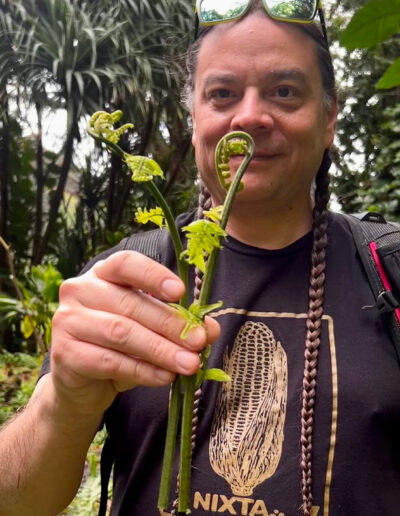O’ahu’s Indigenous food sovereignty efforts
In March, Sean Sherman was invited to O’ahu to learn about Indigenous Hawaiian food sovereignty efforts on the island. There were many highlights.
We were hosted by Kealoha Domingo of Nui Kealoha Hawaii, a Native Hawaiian chef and caterer, and Rachel LaDrig of GoFarm Hawaii, a Stateside Beginning Farmer Training Program and AgBusiness Consulting Service “Growing Hawaii’s Farmers.”
Land as sacred space
Starting the tour at Papahaha Kualo at Wipao, located on 70 acres of cultural, conservation, and agricultural land, we experienced an important site of mythology, history and Native culture. It is likely that ancestors, chiefs, and gods considered it a sacred space, although like Natives everywhere, Hawaiians consider the entirety of the islands, and all land, as sacred space.
Taro (kalo)
It was here that we first encountered taro (kalo, in Hawaiian) an important food crop that genealogically ties Native Hawaiians to the islands and the world that they live in— cultivating taro sustainably honors that tie. Kalo is a staple food at many traditional Hawaiian family meals and celebrations. It acknowledges that the ancestors and gods are present at the table.
The establishment of taro fields is an important aspect of Hawaiian food sovereignty efforts, and can be seen at sites around the island, including Ka’ala Farm and Cultural Learning Center, a site of ancient wet taro fields that were discovered in the 1970’s and have been restored. Today, the space is a Children’s Education Program that provides elementary school children a hands-on opportunity to experience Hawaiian culture by planting kalo, making poi, creating kapa (bark cloth) and learning from kūpuna (elders or ancestors or keepers of knowledge) in the ancient oral tradition. The farm connects children with their cultural heritage.
Coconut)
We met with Manulani Alui Meyer (Aunty Manu) Indigenous Epistemologist and co-founder of Niu Now and her partner Aunty Ngahiraka, for a UluNiu dinner (coconut heritage dinner).
In modern day Hawaii, the coconut is considered to be an ornamental (and a liability, because of the risk of falling coconut injury) and the nuts are mostly cut down before they are mature enough to eat. This is a problem, because almost 50 percent of Hawaiian children are food insecure. Niu Now is working to protect and re-establish coconuts as the ancient food source they are.
Ho’oulu’anina nature preserve
We also visited Ho’oulu’anina nature preserve, a 100-acre nature preserve nestled in Kalihi valley, cared for by Kōkua Kalihi Valley Comprehensive Family Services, a nonprofit community health center.
Through four interwoven program areas, Hoʻoulu ʻĀina seeks to provide people of the ahupuaʻa (Hawaiian term for a large traditional socioeconomic, geologic, and climatic subdivision of land) and beyond, the freedom to make connections and build meaningful relationships with the ʻāina (the land) each other. Here, the community comes together around forest, food, knowledge, spirituality, and healthy activity.
We toured the grounds and saw the restoration of Native plants, including medicinals that are available for use from a small pharmaceutical and healing area, as well as a clearing where people can have access to medicinal plants directly from the plant itself.
Community health center
From there we moved on to Roots Cafe & Market, a federally qualified nonprofit community health center created in 1972 by community members to meet a need for proper health care. Roots is an education center and food hub that includes garden curriculum, cooking education, an affordable cafe and much more.
Indigenous dinner
Kealoha Domingo and I cooked a collaborative Indigenous dinner at WaiWai Collective, a work, event, educational, cultural programming, and entertainment space run by a collaborative network of members who want to be a part of a movement for positive change for Hawaiʻi and beyond.
Sean Sherman is looking forward to visiting O’ahu again in the fall for the 13th Annual Hawaiian Food & Wine Festival, where I will present, and where we will continue to learn how we can collaborate on sovereignty exchange with Native Hawaiian food and knowledge keepers.












